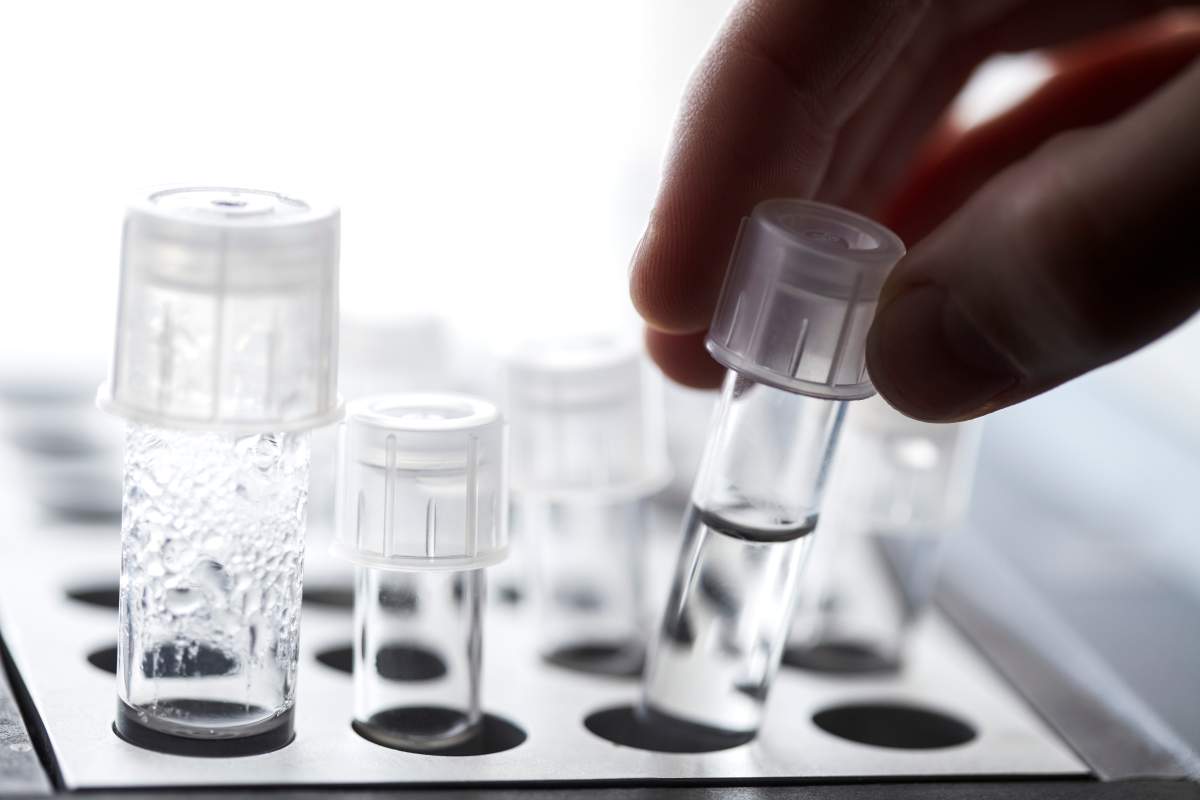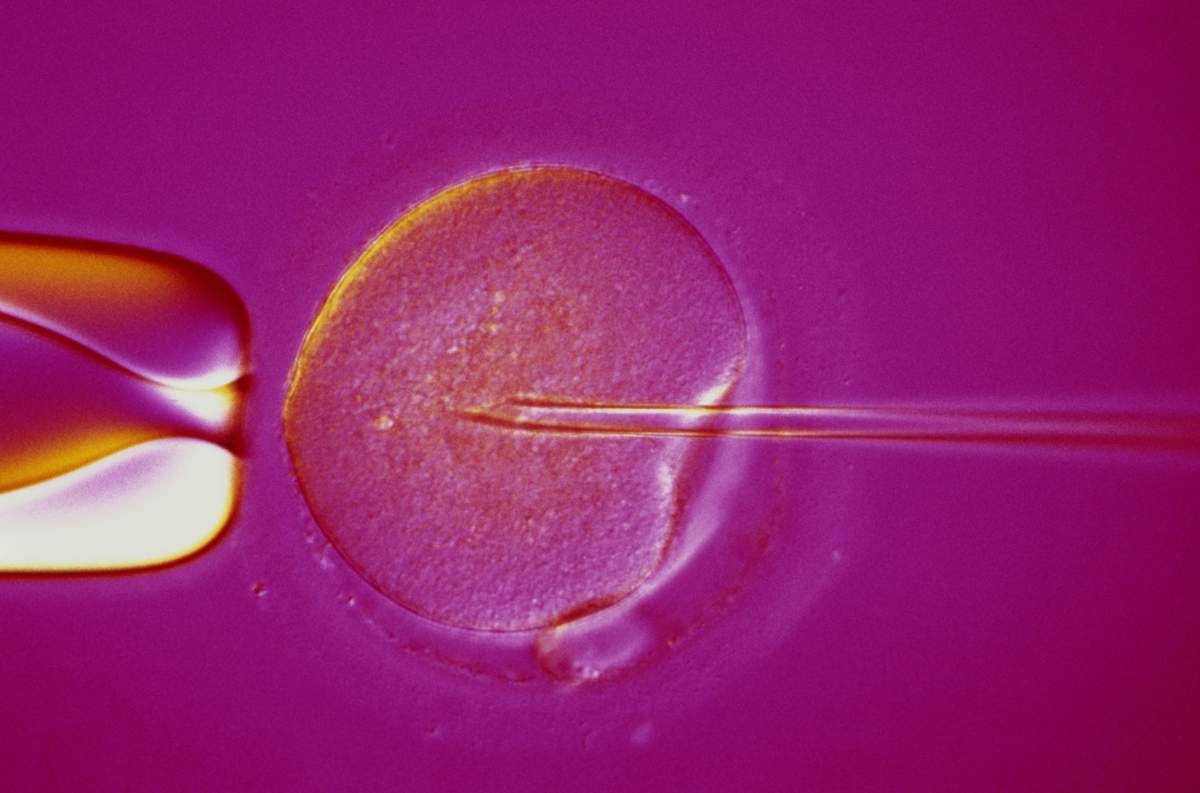This is the latest article in a Global News investigation into fertility in Canada, and the emotional and financial impact infertility has on Canadians struggling to conceive.

***
It took Rebecca Nielsen a lot of fertility treatments to become a mom last fall.
The 41-year-old and her husband Kevin, who is a Global News employee, a met in 2009. In 2010, when she was 35, they stopped using birth control. A year later, ovulation trackers and scheduled intercourse became part of their lives.
“Your prime conception years physically are between 18 to 24,” she acknowledged, “when you’re doing everything you can not to get pregnant.
“Then you’re in debt. Then you break up with your long-term boyfriend and need to ‘find yourself.’ Then you find ‘the guy.'”
By 2012, the two had tied the knot but were still struggling to make a baby.
Some couples in this situation turn to naturopaths, acupuncturists or chiropractors who specialize in fertility.
Others try to improve their chances of conception by making certain lifestyle changes (like healthier eating and cutting out certain vices), which sometimes works. Not for the Nielsens, though.
WATCH: How to have a baby: Fertility clinic founders share 5 dos and don’ts

Their family doctor suggested they reduce their stress levels and just keep trying. When a year of that didn’t work, the couple got a referral to the big guns: the Hannam Fertility Clinic in Toronto.
Nielsen estimates she had to go there every other day — either for blood work, ultrasounds or procedures — over the two years that followed. She thinks the parking alone cost her about $3,500.
The whole process cost the couple roughly $100,000, since it was before Ontario introduced fertility funding. A lot of that was reimbursed through Nielsen’s drug plan and tax credits. Family also helped.
As is the protocol with all new patients, the first step is a battery of fertility tests to try and figure out what the problem is.
“For example, if someone comes in and turns out their thyroid is unbalanced, we help them with their hormone level and they’re more likely to get pregnant naturally,” said Tom Hannam, the clinic’s founder and one of its doctors.
“Everything’s linked to everything else.”
In rare cases, if there’s a problem with the uterus or fallopian tubes, surgery might be needed.
In the Nielsen’s case, the test results were inconclusive.
So a series of “chemical cocktails” started off their treatment.
A cocktail of fertility drugs
“I was taking at one point, a vitamin mix cocktail that was a combination of 13 pills,” Nielsen said. “I used to joke you’d hear me walking down the hallways because I had so many pills in my stomach.”
That particular chemical concoction included prenatal vitamins, CoQ10, Omegas, iron, vitamins C, D and B12.
Fertility doctor Ellen Greenblatt, who’s the medical director of the Mount Sinai Fertility and IVF unit, explains there are three classes of fertility drugs:
- Oral — tablets like clomiphene citrate (aka “Clomid” or Serophene)
- Off-label — letrozole (a.k.a. Femara, which is similar to clomiphene but it’s “off label,” meaning it’s traditionally used for something else — in this case to prevent breast cancer recurrence — but has been shown to also help treat infertility.) At one point Nielsen was put on HGH (human growth hormone).
- Injectable — a range of gonadotropins like Gonal-F, Puregon and Menopur.
The drugs taken (and in what dose) are dependent on the treatment, how many eggs a woman has to begin with, where she is in her cycle and what shows up in her blood work and ultrasounds.
For instance, the tests might show the uterine lining needs to be thicker in order to create an optimal environment for embryo implantation. The prescription would be adjusted accordingly.
Nielsen’s “drug cocktail” would sometimes include a combination of pills, patches and injections. Each came with their own side-effects.
“You don’t feel like yourself because you’ve been so pumped of hormones,” she admitted. “You’re tired, you’re lethargic.”
IUI — ‘Sending in the marines’
Apart from fertility drugs, the first line of offence Nielsen’s doctor recommended was intrauterine insemination (IUI). It’s a common treatment for couples with unexplained infertility that can range in price from $1,500 to as high as $4,000 in Toronto, and is often paired with a $500 sperm wash.

Get weekly health news
“It’s like sending in the marines,” Nielsen said.
“They take the best, smartest, strongest and fastest — the few, the proud, the brave —and send them in on a covert mission and hope they’re successful.”
Once the model swimmers are chosen, they’re given a little boost and shipped into the uterus through a tiny catheter that Nielsen recalls being only slightly thicker than a strand of hair and feeling no worse than a pap smear.
The hope is that the sperm will make it to the egg and fertilize it naturally.
An ultrasound technician watches a monitor to ensure the catheter releases the “marines” at the right place, while the patient lays back with their feet in stirrups.
“Then you go home and you cross your legs and you hope it takes.”
The other alternative, if there’s male factor infertility or in the case of a female same-sex couple, is to use donor sperm. Sperm is ordered from sperm banks in the U.S., that offer profiles of the donors, and then shipped to a fertility clinic.
While the effectiveness of any treatment always goes down with age, IUI’s average success rate is said to be 12 to 15 per cent per cycle. It drops to about five per cent per cycle for women around 40, according to Greenblatt.
Nielsen, then 37, tried four rounds of IUI within six months in 2013. They were all unsuccessful.
WATCH: Fertility treatment success rates, explained by Dr. Caitlin Dunne of the Pacific Centre for Reproductive Medicine in Vancouver

IVF, the final frontier
Nielsen hoped for a better prognosis with in vitro fertilization (IVF). It’s the most expensive fertility treatment but also has the best odds.
IVF is paired with the injectable gonadotropins that stimulate the ovaries to produce, on average, eight to 15 eggs (compared to the standard one egg that’s released a month).
Donor eggs can alternatively be used if needed. However, it’s important to note you cannot pay anyone to be an egg donor in Canada. So any exchange would have to be altruistic.
The donor would have to undergo a round of IVF for the eggs to be harvested, so it’s also not cheap.
Fortunately, Nielsen didn’t have problems producing eggs. That first round she “whipped out” 18 of them. The ultrasounds showed her ovaries, which are typically the size of a walnut, grow to the size of chicken eggs.
She compares it to having swollen glands when you’re sick.
“You could physically feel them. They feel really heavy and sore.”
In IVF, eggs are extracted with a needle from a woman’s body. Nielsen remembers being in “more of an operating theater” rather than an exam room for this procedure.
“They sedate you but you’re not completely out of it.”
She recalls “a lady with a light on her head talking to me, saying, ‘everything is good.'”
The “exciting” part for her was finding out how many eggs were retrieved. Of the 18 she produced, 14 got fertilized right away.
There are two fertilization options in IVF. One is for the eggs to be put into a dish and sprinkled with some 100,000 sperm in hopes they’ll fertilize the egg “naturally.”
The other, which comes at an additional cost of about $1,500 and the one which Nielsen opted for, is called intracytoplasmic sperm injection, or ICSI (pronounced ‘ick-see’) for short.
As its name suggests, fertilization occurs by injecting the sperm into the egg to guarantee fertilization. At this point, Nielsen didn’t see the point of leaving that to chance.
But fertilization doesn’t mean pregnancy. The embryos need to make it to Day 5 or 6 before being transferred to the uterus (called a fresh transfer) or frozen (called a frozen embryo transfer).
Only four of her 14 embryos reached any of those benchmarks. Two were put on ice (to be thawed and transferred later), and two were put in “fresh.”
None of them took. And there were no answers why.
“The cells may not divide and it may just not work,” Nielsen said.
“You don’t know why it doesn’t work… it just doesn’t work.”
WATCH: The highs and lows of IVF

After that, the Nielsens decided to try one more round of IVF, but this time, they paired it with something called pre-implantation genetic screening (PGS) also known as comprehensive chromosome screening (CCS).
It cost about $5,000, on top of the $23,000 the couple was already paying for the second round of IVF. However it increased their chances of conception to 72 per cent. Other couples may see an average success rate of 60 to 70 per cent with the screening, according to fertility doctor Caitlin Dunne of the Pacific Centre for Reproductive Medicine in Vancouver.
At the time (in 2014, when Nielsen was 39), the test was not recommended as an add-on for “genetically healthy” couples. Dunne says it’s now considered to be “most helpful” for women over 38 who make more than two embryos through IVF.
It involves a small biopsy of cells from what would become the placenta in each embryo. The samples are then sent to a lab, where they’re analyzed for a variety of chromosomal and genetic defects.
“What came back three weeks later,” Nielsen said, “freakin’ blows my mind.”
Of the eight embryos they had analyzed, all but one had chromosomal problems that would have either resulted in a failed implantation, a miscarriage or a baby with Down Syndrome.
The test saved them potentially multiple rounds of “heartbreak.”
Nielsen got emotional when she spoke about the day that “one genetically perfect embryo” was transferred.
“This is the magical part for me,” she said before taking a big breath.
“They put you on the gurney and wheel all the equipment into this room. There’s an incubator and on top of it there’s a flat screen TV.”
As she held her husband’s hand, an image of the embryo they were about to put inside her was put on the screen.
“I may have just seen the first picture of my daughter and she hasn’t been born yet,” she recalls thinking.
Nine months later, her beautiful baby Margaret was born healthy, happy and “chatty.”
Nielsen says the past 14 months with her now “super funny” toddler made the emotional roller-coaster and huge financial cost all worth it.
“The crazy part? I want to do it again,” Nielsen said.
“Don’t tell my husband.”
WATCH: Mother shares her advice to couples who are just about to start fertility treatments

The infographic below takes a closer look at the most common fertility treatments, which can either be used alone (like tablets) or in conjunction with other treatments.
Dunne explains the most common treatment combinations in the video at the top of the story.
Infographic by Deepak Sharma, Global News
READ MORE: How fertility coverage varies across Canada










Comments